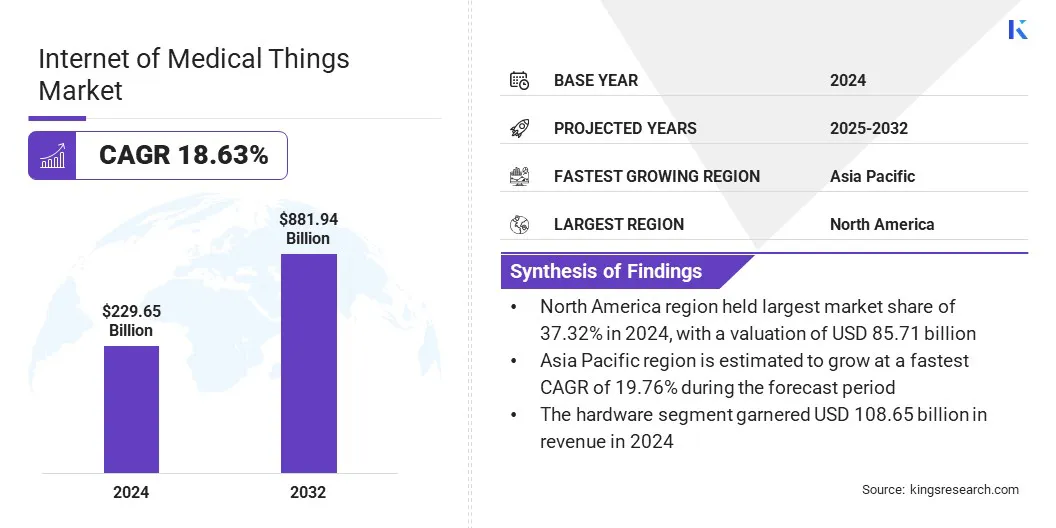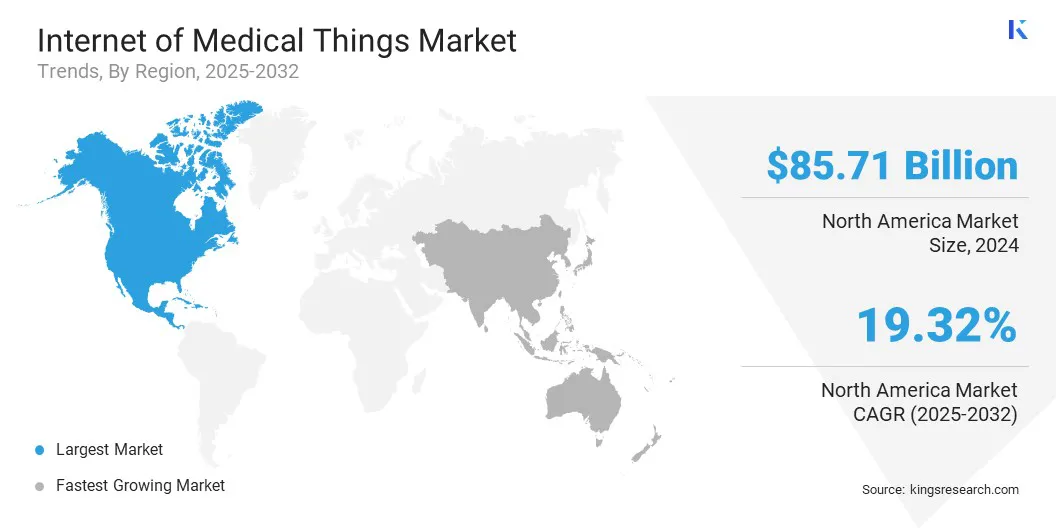buyNow
Internet of Medical Things Market
Internet of Medical Things Market Size, Share, Growth & Industry Analysis, By Offering (Hardware, Software, Services), By End User (Hospitals & Clinics, Home Healthcare, Research Institutes & Academics, Others), By Platform (Medication Management, Clinical Operations & Workflow Management), and Regional Analysis, 2025-2032
pages: 160 | baseYear: 2024 | release: July 2025 | author: Versha V.
Internet of Medical Things Market Overview
The global internet of medical things market size was valued at USD 229.65 billion in 2024 and is projected to grow from USD 266.78 billion in 2025 to USD 881.94 billion by 2032, exhibiting a CAGR of 18.63 % during the forecast period.
The market is growing, due to the rising demand for continuous patient monitoring that streamlines workflows and reduces hospital stays. Integration of secure cloud connectivity enables real-time data access and efficient, coordinated management of connected medical devices.
Key Market Highlights:
- The internet of medical things industry size was valued at USD 229.65 billion in 2024.
- The market is projected to grow at a CAGR of 18.63% from 2025 to 2032.
- North America held a market share of 37.32% in 2024, with a valuation of USD 85.71 billion.
- The hardware segment garnered USD 108.65 billion in revenue in 2024.
- The hospitals & clinics segment is expected to reach USD 319.52 billion by 2032.
- The patient monitoring segment is anticipated to register the fastest CAGR of 21.74% during the forecast period.
- The market in Asia Pacific is anticipated to grow at a CAGR of 19.76% during the forecast period.
Major companies operating in the internet of medical things market are Microsoft, Armis Inc., IBM, Cisco Systems, Inc., Resideo Technologies Inc., SAP, General Electric Company, Securitas Healthcare LLC, Medtronic, Robert Bosch GmbH, Koninklijke Philips N.V., PTC, Huawei Technologies Co., Ltd., Oracle, and Siemens Healthineers International AG.

The market is driven by the growing adoption of Electronic Health Records (EHRs) that streamline clinical workflows and enhance patient care. Integrated EHR systems enable caregivers to quickly access and update critical patient information from any location, supporting informed, timely decision-making.
By improving documentation, medication safety, referral management, and mobile charting, EHRs help reduce administrative burden, boost clinician productivity, and ensure consistent, high-quality care across diverse healthcare settings.
- In September 2024, Oracle Health announced enhancements in EHRs designed to improve clinician efficiency and care quality. The updates enable faster access to critical patient information, streamlined chart reviews, advanced mobile documentation, safer medication processes, and improved referral management. With predictable quarterly releases, these innovations help healthcare organizations enhance workflows and deliver better, more informed patient care.
Market Driver
Rising Demand for Continuous Patient Monitoring
The market is driven by the need for continuous patient monitoring that reduces staff workload and shortens hospital stays. Advanced wearable biosensors integrated with monitoring platforms enable real-time health tracking and streamlined clinical workflows.
This supports timely decision-making and efficient resource allocation, allowing healthcare providers to manage rising patient volumes and operational costs. Continuous monitoring addresses key pressures in modern healthcare systems by enhancing care delivery in hospitals and homes.
- In August 2024, Royal Philips partnered with smartQare to integrate its viQtor solution with Philips’ clinical patient monitoring platforms. This collaboration targets seamless, continuous patient monitoring in and out of hospitals across Europe. By enabling interoperability between wearable biosensors and systems, the partnership aims to reduce staff workload, shorten hospital stays, and simplify data-driven decision-making through accessible, user-friendly platforms.
Market Challenge
Data Privacy and Cybersecurity Risks
The internet of medical things market faces the critical challenge of data privacy and cybersecurity risks, as connected medical devices collect and transmit sensitive patient information. Cyberattacks, data breaches, and unauthorized access can compromise patient safety, violate regulations, and damage trust in digital healthcare.
Companies are implementing robust encryption protocols, multi-factor authentication, and secure cloud storage. They are also conducting regular security audits, adopting industry standards, and developing advanced threat detection systems to ensure the integrity, confidentiality, and availability of patient data across connected healthcare ecosystems.
Market Trend
Integration of Secure Cloud Connectivity in Medical Device Management
The market is registering the trend of integrating secure cloud connectivity in medical device management to enhance care delivery and operational efficiency.
Healthcare providers can access real-time clinical data, manage fleets of equipment remotely, and ensure reliable storage of patient information by enabling devices to connect seamlessly with the cloud.
This approach supports faster, more informed decision-making, facilitates coordinated care across settings, and strengthens data security while enabling scalable, cost-effective management of connected medical devices.
- In March 2024, Onymos and Vapotherm announced a partnership to develop an end-to-end IOMT solution for the Vapotherm HVT 2.0 system. Leveraging Onymos’ Features-as-a-Service platform, the collaboration delivers secure cloud connectivity, remote device management, and real-time clinical data visualization, supporting decision-making and enabling advanced respiratory care in both acute hospital settings and future home environments.
Internet of Medical Things Market Report Snapshot
|
Segmentation |
Details |
|
By Offering |
Hardware (Wearable Devices, Stationary Medical Devices, Implantable Medical Devices), Software (Device Management, Application Management, Data Analytics, Others (Electronic Health Record (EHR) Systems, Telemedicine Software), Services (Integration & Deployment Services, Consulting Services, Others (Support & Maintenance Services, Managed Services)) |
|
By End-user |
Hospitals & Clinics, Homecare/Home Healthcare, Research Institutes & Academics, Others |
|
By Platform |
Medication Management, Patient Monitoring, Clinical Operations & Workflow Management, Preventive Healthcare, Others |
|
By Region |
North America: U.S., Canada, Mexico |
|
Europe: France, UK, Spain, Germany, Italy, Russia, Rest of Europe | |
|
Asia-Pacific: China, Japan, India, Australia, ASEAN, South Korea, Rest of Asia-Pacific | |
|
Middle East & Africa: Turkey, U.A.E., Saudi Arabia, South Africa, Rest of Middle East & Africa | |
|
South America: Brazil, Argentina, Rest of South America |
Market Segmentation:
- By Offering (Hardware, Software, and Services): The hardware segment earned USD 108.65 billion in 2024, due to the rising demand for connected medical devices that enable real-time patient monitoring and streamlined clinical workflows.
- By End-User (Hospitals & Clinics, Homecare/Home Healthcare, Research Institutes & Academics, and Others): The hospitals & clinics segment held 38.51% share of the market in 2024, due to the increasing adoption of connected monitoring systems to enhance patient care, improve operational efficiency, and support timely clinical decision-making.
- By Platform (Medication Management, Patient Monitoring, Clinical Operations & Workflow Management, Preventive Healthcare, and Others): The patient monitoring segment is projected to reach USD 365.02 billion by 2032, owing to the growing demand for continuous, remote monitoring solutions that improve chronic disease management and reduce hospital readmissions.
Internet of Medical Things Market Regional Analysis
Based on region, the global market has been classified into North America, Europe, Asia Pacific, the Middle East & Africa, and South America.

North America accounted for a market share of around 37.32% in 2024, with a valuation of USD 85.71 billion. The region dominates the internet of medical things market, due to its advanced healthcare infrastructure supporting the integration of innovative digital care solutions.
The widespread adoption of connected health platforms enables seamless remote patient monitoring and efficient data management across care settings.
By leveraging secure cloud-based marketplaces and cutting-edge technologies such as generative AI, healthcare providers in the region enhance patient engagement, streamline clinical workflows, and deliver timely, informed care, reinforcing North America's leadership in connected healthcare.
- In February 2025, Validic launched its Health IoT and Remote Patient Management solutions powered by Generative AI in AWS Marketplace. The offering includes the Validic Health IoT platform, remote patient management, logistics, device purchasing, and patient service desk. These solutions are now accessible to AWS Enterprise Healthcare and Life Sciences customers, streamlining procurement and deployment through AWS Marketplace’s digital catalog.
The market in Asia Pacific is poised for significant growth at a robust CAGR of 19.76% over the forecast period. The internet of medical things industry in Asia Pacific is driven by the expansion of telemedicine services that enhance access to quality healthcare across diverse regions.
Providers can deliver remote consultations, continuous patient monitoring, and personalized care by integrating connected medical devices with telehealth platforms.
This approach reduces travel barriers, improves healthcare availability in rural and underserved areas, and supports efficient management of chronic diseases, meeting the increasing demand for accessible, technology-enabled healthcare solutions in the region.
Regulatory Frameworks
- In the U.S., the Food and Drug Administration (FDA) regulates IoMT by setting standards for safety, effectiveness, and cybersecurity of connected medical devices used in healthcare settings.
- In India, the Central Drugs Standard Control Organization (CDSCO) regulates IoMT by overseeing approval, safety, and quality standards for connected medical devices and ensuring compliance with applicable regulations.
Competitive Landscape
Companies in the internet of medical things market are actively pursuing strategies such as mergers and acquisitions, strategic partnerships, and product launches to strengthen their market position.
Key players are expanding portfolios through targeted acquisitions, forming alliances to enhance technological capabilities, and introducing innovative connected medical devices and platforms.
These actions reflect a competitive landscape focused on accelerating market penetration and establishing leadership in delivering integrated, scalable IoMT solutions across diverse healthcare settings.
- In May 2024, GE HealthCare and Tampa General Hospital expanded their partnership with an agreement to deploy advanced imaging and ultrasound technology across TGH Imaging’s outpatient facilities in Florida. This initiative supports IoMT by enabling connected, data-rich diagnostic solutions that improve clinician workflows, enhance patient care, and strengthen healthcare delivery across multiple locations.
Key Companies in Internet of Medical Things Market:
- Microsoft
- Armis Inc.
- IBM
- Cisco Systems, Inc.
- Resideo Technologies Inc.
- SAP
- General Electric Company
- Securitas Healthcare LLC
- Medtronic
- Robert Bosch GmbH
- Koninklijke Philips N.V.
- PTC
- Huawei Technologies Co., Ltd.
- Oracle
- Siemens Healthineers International AG
Recent Developments (Partnerships/Product Launches)
- In March 2025, Cumulocity and Device Authority announced a partnership to enhance security and data management in IoMT. Their joint solution offers automated identity lifecycle management, real-time monitoring, predictive maintenance, and strong regulatory compliance. By implementing zero trust security, the partnership ensures secure, streamlined management of connected medical devices, supporting safer, more reliable healthcare delivery across IoMT environments.
- In February 2025, Validic launched a patent-pending digital remote patient monitoring assistant powered by Generative AI. Integrated with major EHR systems, this solution analyzes and summarizes complex patient data into clear, actionable insights. It enables clinicians to efficiently interpret health trends, maintain documentation compliance, and reduce administrative workload, supporting faster, more informed decision-making within existing clinical workflows.
